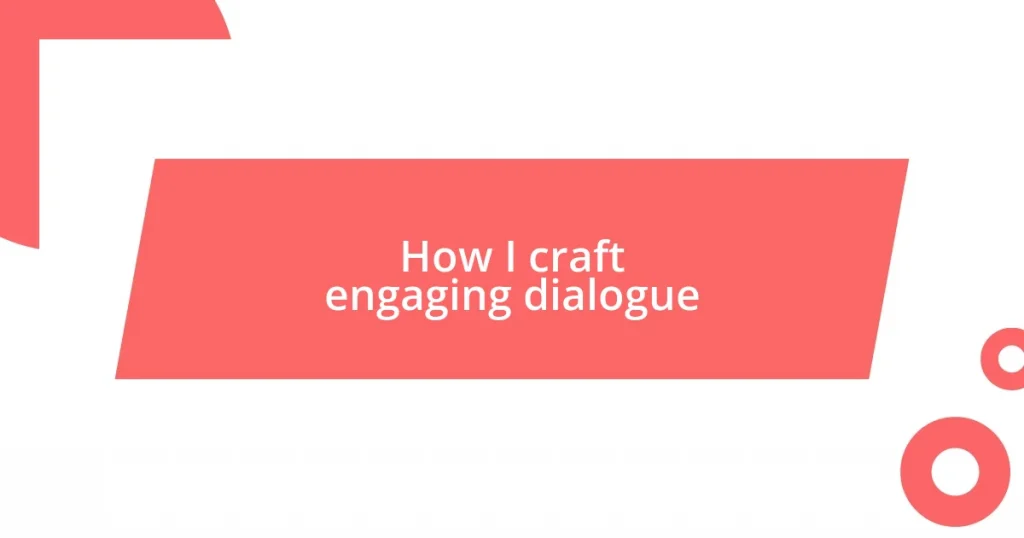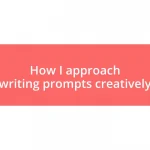Key takeaways:
- Dialogue drives the narrative by revealing character emotions and motivations while creating relatability and empathy for readers.
- Using subtext in conversations adds depth and intrigue, encouraging readers to engage with the characters’ true feelings and intentions.
- Incorporating natural speech patterns and editing for clarity enhances the authenticity and impact of dialogue, making characters more relatable and the narrative more engaging.
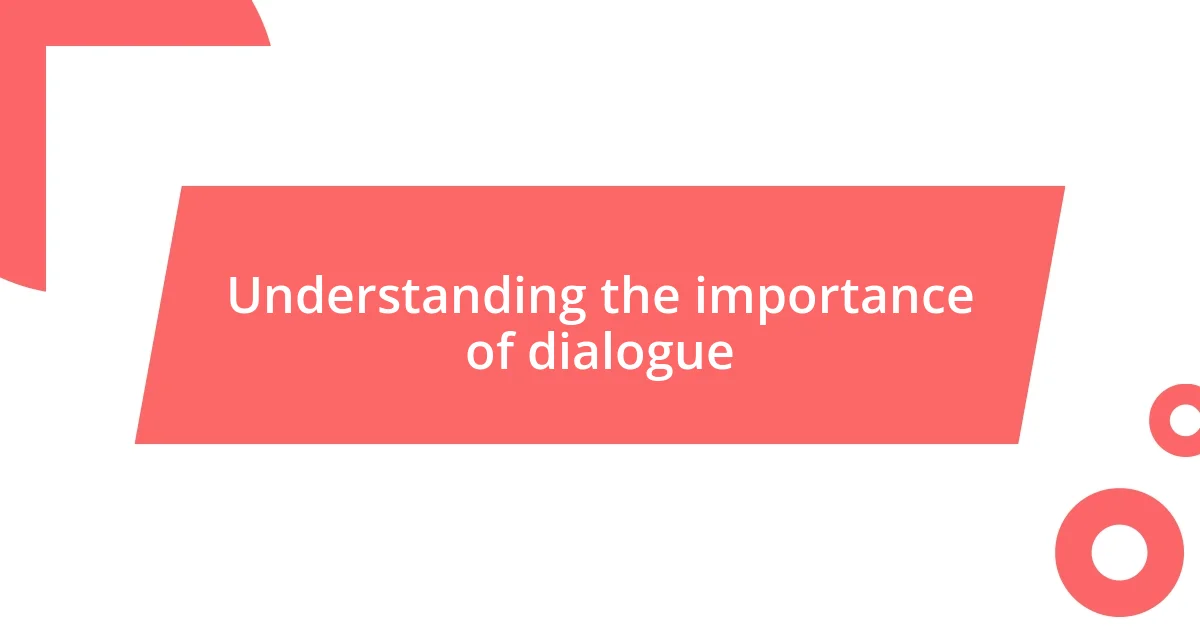
Understanding the importance of dialogue
Dialogue is essential because it drives the narrative forward, revealing character motivations and emotions in ways that exposition simply cannot. I remember struggling with a story where my characters felt flat until I immersed them in a conversation. Suddenly, their personalities sprang to life through their words. Isn’t it fascinating that a simple exchange can add layers and depth to a character?
Moreover, engaging dialogue shapes the reader’s experience, making them feel connected to the characters. I often find myself rooting for characters simply because they expressed their hopes and fears so vividly in conversation. Have you ever felt that rush when a character shares something deeply personal? That’s the magic of dialogue—it creates relatability and empathy, transforming readers into active participants in the story.
It’s also crucial to understand how dialogue can reflect and shape the dynamics between characters. I once wrote a scene where two friends had an argument that spiraled into vulnerability, exposing their insecurities. The tension I crafted through their conversation brought an emotional weight that resonated with readers. How often do conversations reveal unspoken truths that change the course of relationships—both fictionally and in real life?
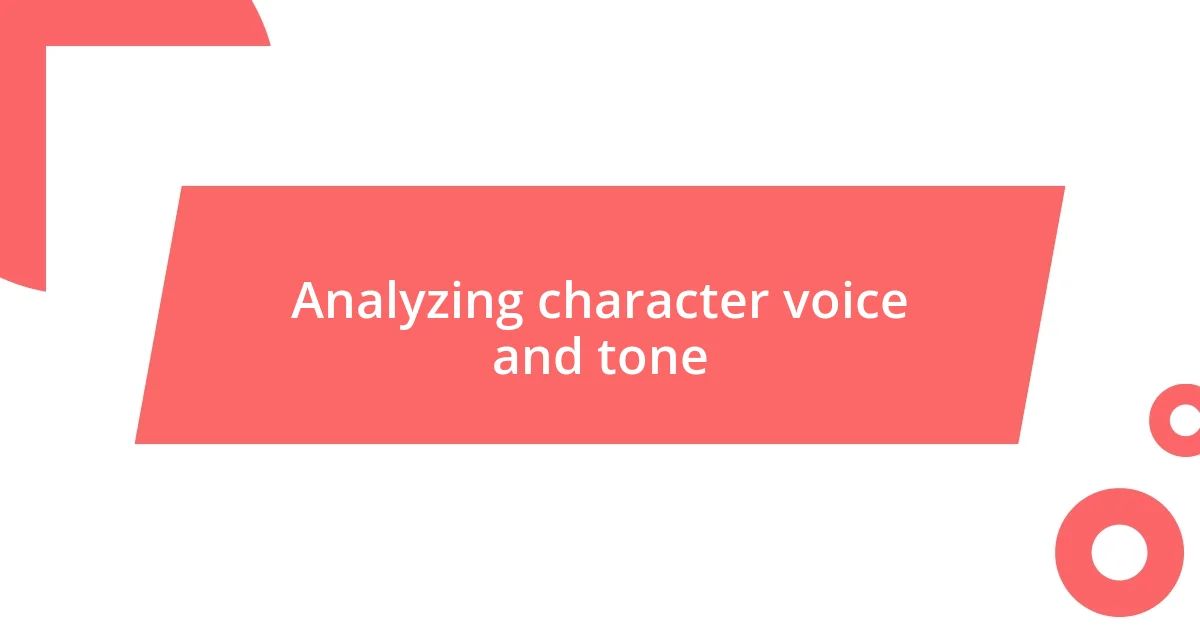
Analyzing character voice and tone
Analyzing character voice and tone is pivotal to creating authentic dialogue that resonates. Every character has a unique way of expressing themselves, influenced by their background, experiences, and emotions. I recall a character I wrote who spoke in short, clipped sentences, reflecting her frustration and urgency. This distinct voice not only shaped her identity but also heightened the tension in the scene, allowing readers to feel her anxiety firsthand.
- Voice refers to the distinct personality and style of a character. Is it formal, casual, sarcastic, or earnest?
- Tone conveys the attitude of the character. Is it optimistic, cynical, or confrontational?
- Characters’ education level, cultural background, and circumstances can greatly influence both voice and tone.
- Using specific word choices and speech patterns can reveal their social status or emotional state, further enriching the dialogue.
These elements work together to create a multifaceted character. I’ve noticed that when I pay careful attention to the unique voice and tone of my characters, the dialogue naturally flows, drawing readers in and making them invest emotionally in the story.
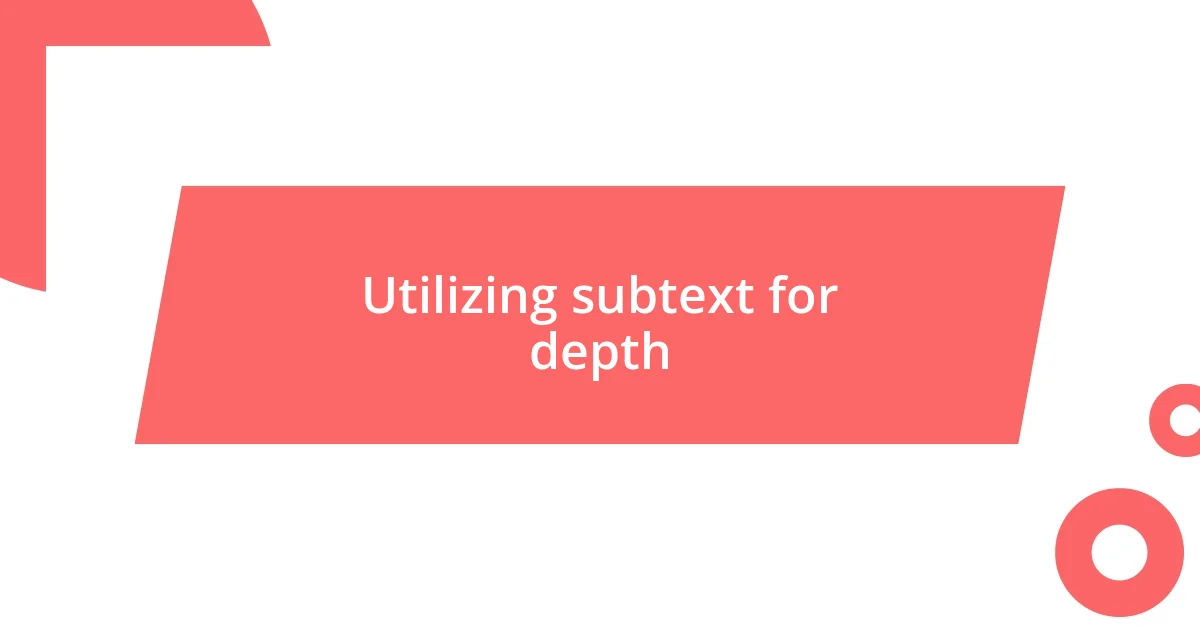
Utilizing subtext for depth
Utilizing subtext in dialogue adds a profound layer of meaning to interactions between characters. When characters say one thing but mean another, it creates intrigue. I’ve experienced this firsthand with a character who smiles while delivering a biting remark. That contrast captured the tension and hinted at deeper emotions simmering below the surface. Have you ever encountered a situation where what wasn’t said was more powerful than the spoken words? It’s those moments that provide rich ground for character development, inviting readers to read between the lines and engage on a deeper level.
One particularly enlightening moment for me was writing a scene where two lovers discussed mundane plans for the weekend, yet their underlying feelings of doubt and insecurity created a palpable tension. The subtext allowed their love to shine through while simultaneously revealing cracks in their relationship. I’ve recognized that those subtle hints often resonate more with the audience than direct declarations. It’s almost like playing a game — what’s left unsaid beckons readers to unravel the mystery of the characters’ true feelings and intentions.
Similarly, subtext enhances the conflict in a scene. When two characters argue, and one remains calm, their silence may express disapproval or resignation. I remember crafting a tense moment between a parent and child where the parent’s clipped responses held a world of disappointment. In that way, the dialogue wasn’t just what they were saying, but what they weren’t saying that conveyed volumes. It teaches us that subtext isn’t just a stylistic choice; it’s a powerful tool to build conflict and invoke emotion in readers.
| Direct Dialogue | Subtext |
|---|---|
| “I’m fine.” | Implying distress behind a calm facade. |
| “You always forget!” | Suggesting deeper issues of trust and accountability. |

Creating conflict through dialogue
Creating conflict through dialogue can ignite tension and push the narrative forward in fascinating ways. I’ve found that by allowing characters to directly confront each other, I can elevate the stakes in a scene, making readers lean in with anticipation. For instance, I was once writing a heated exchange between two siblings, where years of unresolved issues spilled over. The words they used were sharp, revealing not just anger but a deep-seated hurt, and I could almost feel the weight of those unspoken truths as if I were eavesdropping on a real-life quarrel.
Conflict doesn’t always have to be loud or aggressive; it can simmer beneath the surface, too. I recall a tense family dinner scene I crafted that revolved around a seemingly mundane topic—what to order for dinner. The characters’ snippy remarks and heavy silences spoke volumes about the underlying resentment festering among them. Isn’t it ironic how a simple choice can become a battleground? It’s these layers of disagreement that often resonate the most with readers, reflecting the complexities of real-life relationships.
Moreover, conflict in dialogue can take unexpected turns, leading to surprising revelations. For example, while writing a conversation between a boss and an employee, the employee started out defensive but slowly revealed vulnerabilities when pressed. I’ve discovered that this sort of dynamic not only builds conflict but also enriches character development, transforming it from mere quarrel to an exploration of personal struggles. In my experience, it’s this blend of confrontation and unexpected vulnerability that keeps the dialogue engaging and deeply relatable.
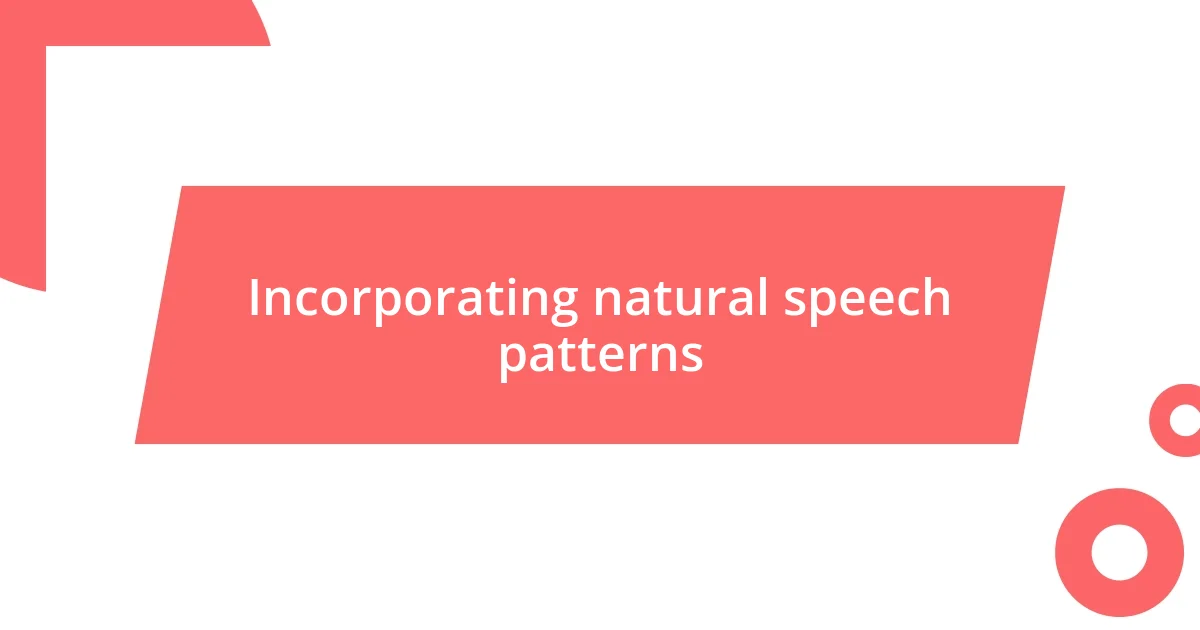
Incorporating natural speech patterns
Incorporating natural speech patterns is essential for making dialogue resonate with readers. I remember when I first learned to capture the rhythm of real conversations in my writing. Instead of using flawless sentences, I started embracing interruptions and verbal tics. Reflecting on how my friends and I interact, I realized that pausing mid-sentence or asking questions like “You know what I mean?” adds authenticity. Doesn’t it feel more relatable when characters stumble over their words or catch themselves in a lie?
One of my favorite techniques is to sprinkle in regional phrases or colloquialisms. For instance, I once had a character from the South who would say “y’all” instead of “you all.” It brightened their personality and gave readers a sense of place. This subtle touch reflected who they were without needing lengthy descriptions. Isn’t it fascinating how a single word can instantly create a vivid picture of a character?
I’ve also found that using tone and body language in conjunction with dialogue can be incredibly powerful. In a scene where a character is nervous, I might describe them fidgeting with their hands while saying “I’m totally fine” in a shaky voice. It’s that juxtaposition between speech and action which provides depth and makes the dialogue feel truly alive. Haven’t you ever felt those mixed signals in your own conversations? It’s those little nuances that invite readers to really immerse themselves in the story.
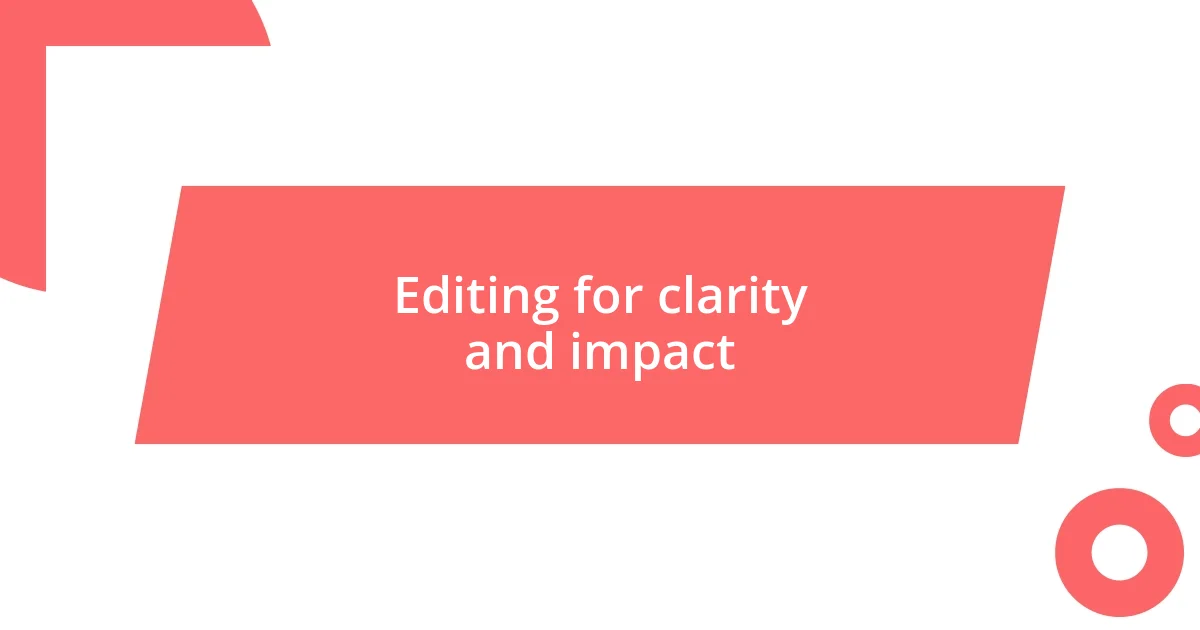
Editing for clarity and impact
Editing isn’t just about correcting grammar; it’s about shaping clarity and impact. I remember revisiting a dialogue-heavy scene that felt muddled. As I cut unnecessary filler words and rephrased clunky sentences, the exchange transformed into a brisk, engaging back-and-forth. That’s when it hit me—sometimes, less really is more. Isn’t it liberating to strip away the excess and let the characters’ voices shine?
I often find that reading dialogue aloud helps solidify its punch. As I do this, I can usually catch phrases that sound awkward or overly formal. Just last week, I was fine-tuning a character’s confession, and upon hearing it, I realized it needed to be more vulnerable and raw. I adjusted the tone, allowing for pauses that conveyed hesitation and emotion. This small change turned a simple statement into a heartfelt revelation. How often do we miss the emotion in our writing until we let it flow from our lips?
Emphasizing impactful dialogue can also mean prioritizing subtext—the underlying meaning between the lines. I recall a scene where a character was apologizing, but their words felt almost robotic. By changing their inner thoughts into a reflection of their fear and regret, I turned a mundane apology into a moment that truly resonated. For me, capturing these layers has always been key to creating dialogue that doesn’t just communicate but stirs feelings. Isn’t that the goal—to have our words linger in the reader’s mind long after the page is turned?
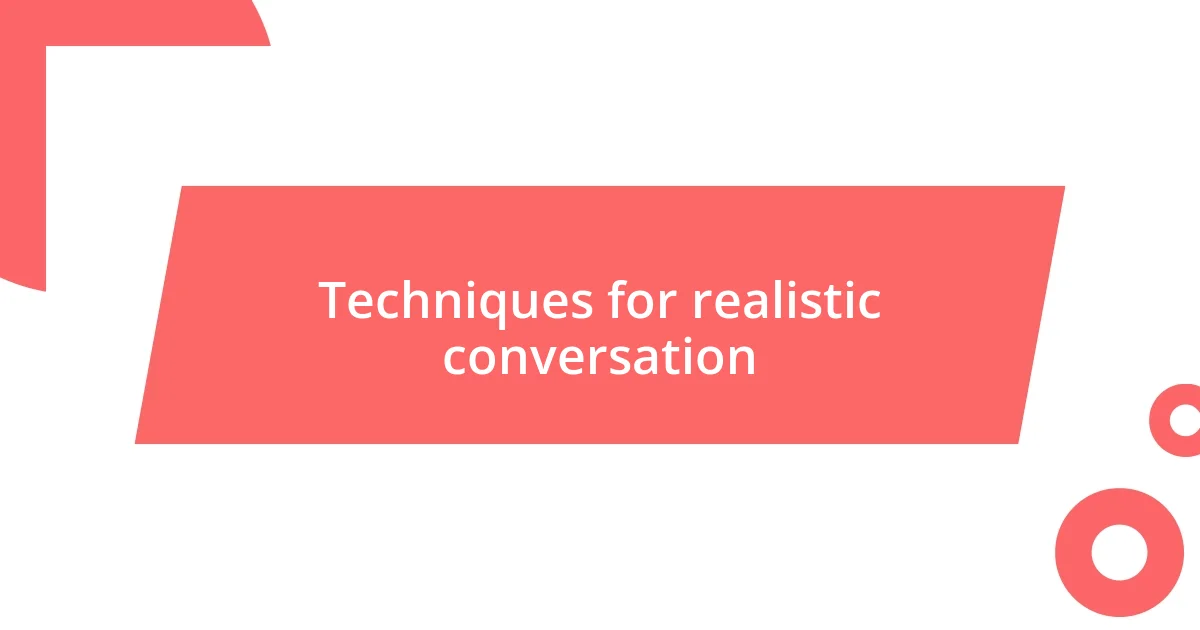
Techniques for realistic conversation
One technique I find invaluable for crafting realistic dialogue is to consider the unique backgrounds and personalities of each character. When I was developing a dialogue for a character who grew up in a strict household, I noticed they tended to choose their words carefully, often hesitating before speaking. This not only revealed their personality but also created tension in the exchange, making readers more invested. Have you ever noticed how our upbringing can shape the way we communicate? I think it adds incredible depth to our characters.
Another effective method is to mimic real-world interruptions and overlaps in conversation. I once wrote a scene where two characters were debating passionately. Their sentences overlapped, and they spoke over each other, echoing how discussions can sometimes go awry in real life. It not only made the dialogue feel vibrant but also brought out the characters’ emotions—frustration, excitement, and urgency. Isn’t it intriguing how a simple overlap can convey so much about the relationship between characters?
Listening to conversations around me has been a game-changer. Whether it’s at a café or in a waiting room, I pay attention to how people communicate. I remember hearing a couple where one would start a story, only to be interrupted by the other with a witty quip. It added layers to their interaction and created a sense of camaraderie. That’s the beauty of dialogue—it becomes dynamic when it mirrors the ebb and flow of real-life exchanges. How often do we overlook these subtle moments that could enrich our writing? Embracing those nuances has certainly enhanced the authenticity in my character dialogues.










